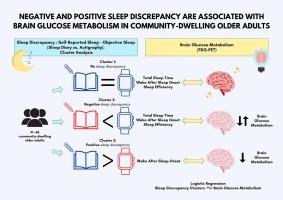Sleep discrepancy and brain glucose metabolism in community-dwelling older adults
IF 1.7
Q3 CLINICAL NEUROLOGY
引用次数: 0
Abstract
Sleep discrepancy (negative discrepancy reflects worse self-reported sleep than objective measures, such as actigraphy, and positive discrepancy the opposite) has been linked to adverse health outcomes. This study is first to investigate the relationship between sleep discrepancy and brain glucose metabolism (assessed globally and regionally via positron emission tomography), and to evaluate the contribution of insomnia severity and depressive symptoms to any associations. Using data from cognitively unimpaired community-dwelling older adults (N = 68), cluster analysis was used to characterise sleep discrepancy (for total sleep time (TST), wake after sleep onset (WASO), and sleep efficiency (SE)), and logistic regression was used to explore sleep discrepancy’s associations with brain glucose metabolism, while controlling for insomnia severity and depressive symptoms. Lower glucose metabolism across multiple brain regions was associated with negative discrepancy for WASO and SE, and positive discrepancy for WASO only (large effect sizes; β ≥ 0.5). Higher glucose metabolism in the superior parietal and posterior cingulate regions was associated with negative discrepancy for TST (large effect sizes; β ≥ 0.5). These associations remained when controlling for insomnia severity and depressive symptoms, suggesting a unique role of sleep discrepancy as a potential early behavioural marker of brain health.

社区老年人的睡眠差异与脑葡萄糖代谢
睡眠差异(负差异反映自我报告的睡眠比客观测量(如动图)更差,正差异则相反)与不良健康后果有关。本研究首次调查了睡眠差异与脑葡萄糖代谢(通过正电子发射断层扫描进行全球和区域评估)之间的关系,并评估了失眠严重程度和抑郁症状对任何关联的影响。利用认知功能未受损的社区居住老年人(68 人)的数据,采用聚类分析来描述睡眠差异(总睡眠时间 (TST)、睡眠开始后唤醒 (WASO) 和睡眠效率 (SE)),并采用逻辑回归来探讨睡眠差异与脑葡萄糖代谢的关系,同时控制失眠严重程度和抑郁症状。多个脑区较低的葡萄糖代谢与 WASO 和 SE 的负差异相关,仅与 WASO 的正差异相关(效应大小较大;β ≥ 0.5)。上顶叶和后扣带回区域的葡萄糖代谢较高与 TST 的负差异相关(效应量大;β ≥ 0.5)。在控制失眠严重程度和抑郁症状后,这些关联仍然存在,这表明睡眠差异作为大脑健康的潜在早期行为标记具有独特的作用。
本文章由计算机程序翻译,如有差异,请以英文原文为准。
求助全文
约1分钟内获得全文
求助全文

 求助内容:
求助内容: 应助结果提醒方式:
应助结果提醒方式:


